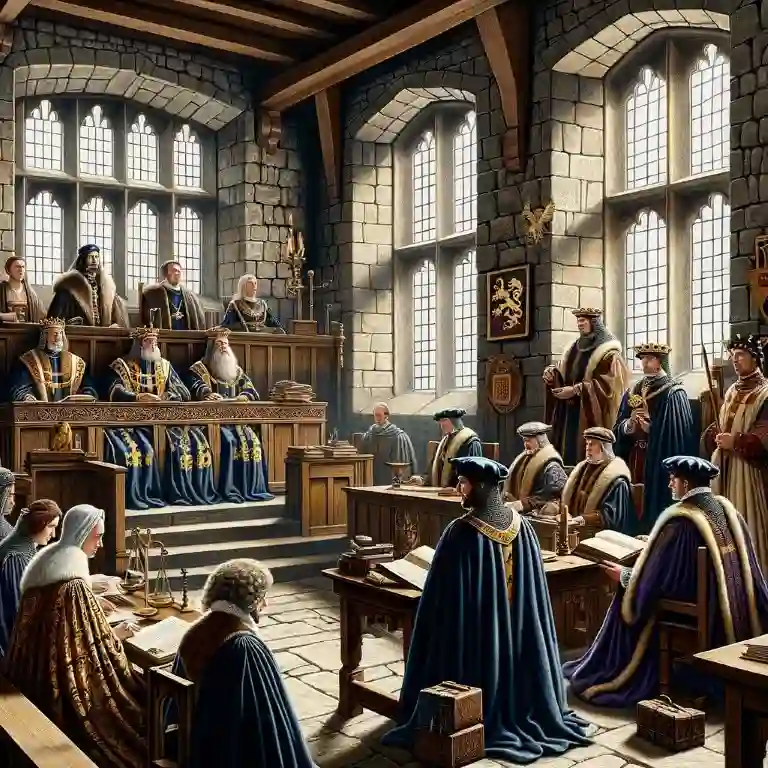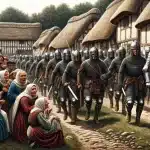Last Updated on 18/03/2024 by Alex Hamlyn
Table of Contents
The context of medieval witchcraft from the Normans to Plantagenet rule
The historical backdrop of medieval witchcraft in England is marked by significant periods that shaped its culture, laws, and societal beliefs, notably witchcraft. The Norman Conquest of 1066 under William the Conqueror introduced profound changes, laying the groundwork for the transition to the Plantagenet dynasty in 1154 with Henry II’s ascension.
This era, initiated by the Normans, is generally considered to have concluded by the late 12th century, marking a transition from Norman to Plantagenet rule. King Stephen’s death in 1154, a Norman descendant whose reign was plagued by “The Anarchy,” a civil war and political instability, ended the Norman dynasty. Stevens reign was marked by conflict with his cousin, Empress Matilda, who also had a claim to the throne. The accession of her son, Henry II, representing the Angevin kings, heralded the start of the Plantagenet era, a new chapter in English history characterized by significant legal and administrative reforms.
Evolution of Witchcraft Perceptions During the Plantagenet Era
The concept and perception of witchcraft underwent significant evolution during the Plantagenet era, spanning from the late 12th to the late 15th century. Initially rooted in local folklore and pagan traditions, the understanding of witches and witchcraft focused on maleficium, harmful magic aimed at causing misfortune or harm to others. This period did not witness the intense witch hunts and trials that would come later; however, there were sporadic cases and accusations, reflecting a legal recognition of the supernatural. The most notorious witch trials of English history were still centuries away.
The early instances of witchcraft accusations were typically less about diabolism and more concerned with causing harm or misfortune. The Church’s growing influence began to shape beliefs and responses, distinguishing between ‘natural magic,’ seen as acceptable, and ‘demonic magic,’ which was condemned.
Legal Framework and Church Influence
The first significant legal statute against witchcraft in England, passed under King Henry V in 1401, known as “De heretico comburendo,” (On the Burning of Heretics) was primarily aimed at suppressing heresy but it would also set a precedent for later witchcraft-specific laws. Throughout the 14th and 15th centuries, the intertwining of heresy with sorcery and witchcraft concerns grew, with the Church playing a pivotal role in defining and combating what it considered heretical or supernatural practices.
Alchemy, astrology, and herbalism were commonly practiced during this era, sometimes overlapping with witchcraft. While some of these practices were seen as being connected to the supernatural, many were simply the wisdom of the day. Modern medicine and scientific understanding – even of things we take for granted today, such as germ theory, were still far off in the future. (And let’s be honest, modern medicine would probably seem like witchcraft and magic to a citizen of the 1400s.) These practices, along with local and folk beliefs, created a blend of pagan traditions and Christian elements.
Throughout the 14th and 15th centuries, there was a growing concern about heresy, which often intertwined with beliefs about sorcery and witchcraft. The Church played a significant role in shaping beliefs and responses to what was considered heretical or supernatural practices.

Witchcraft Accusations and the Plantagenet Context
Although the Plantagenet period did not feature large-scale witch hunts, it laid the groundwork for future attitudes towards witchcraft. Occasional cases, changing legal frameworks, and the evolving cultural and religious context contributed to shaping perceptions and treatments of witchcraft. This era saw a gradual shift from localized folklore to a framework increasingly influenced by Church doctrine and legal standards, setting the stage for the systematic witch-hunts of later centuries.
The Plantagenet dynasty’s contribution to the evolution of witchcraft perceptions is notable for its complexity and the subtle shifts that occurred. While the notorious witch trials of the 16th and 17th centuries were yet to come, the Plantagenet era’s developments in legal, cultural, and religious spheres played a crucial role in shaping the future of witchcraft beliefs and persecution in England.
The transition from the Norman period to the Plantagenet rule in England marked a significant shift in governance, culture, and societal beliefs, including those surrounding witchcraft. The Plantagenet era, characterized by legal reforms, the Church’s growing influence, and evolving societal norms, laid the foundations for the complex and often tragic history of witchcraft perceptions and persecutions in later centuries.
The consequences were coming.
Read more in this series
Witchcraft in Britain
An Introduction
Witches in Roman Britain
(1st-5th century)
Viking Britain and Witchcraft
(8th-11th century)
Medieval Britain and Witchcraft
(5th century onward)
Plantagenet and High Medieval Britain (12th-15th century)
17th Century: The Peak of Witch Hunts in Britain
Modern Britain And Witchcraft – As Strange As Ever
Witchcraft and the Celts
(Pre – AD43)
Witches in Saxon Britain
(5th-11th century)
Norman Britain and Witchcraft
(11th-12th century)
Early Modern Period and Restoration (15th-18th century)
Victorian Britain and Witchcraft
(19th-20th century)
Famous Witches in British History
(Plus one Witch Hunter)



